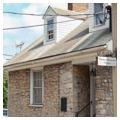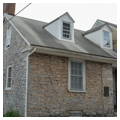Built for Thomas Harrison, who is regarded as the town's founder, this is the oldest house in Harrisonburg. Here the first Rockingham County courts met and Bishop Francis Asbury conducted the county's first Methodist services. The small two-bay house built of coursed rubble limestone has a gable roof pierced by two dormers and an interior-end brick chimney that serves the corner fireplaces of the two first-floor rooms. Situated above a spring, the house was originally entered through the gable end. That entrance is now obstructed by a nineteenth-century building connected to the Harrison House by a stone passage. In addition to its historic value, the building is also a fine illustration of the rich masonry tradition found in the eighteenth-century architecture of the Valley.
You are here
Thomas and Sarah Harrison House
If SAH Archipedia has been useful to you, please consider supporting it.
SAH Archipedia tells the story of the United States through its buildings, landscapes, and cities. This freely available resource empowers the public with authoritative knowledge that deepens their understanding and appreciation of the built environment. But the Society of Architectural Historians, which created SAH Archipedia with University of Virginia Press, needs your support to maintain the high-caliber research, writing, photography, cartography, editing, design, and programming that make SAH Archipedia a trusted online resource available to all who value the history of place, heritage tourism, and learning.





